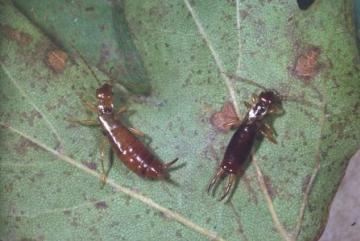Species Account for Apterygida media
Apterygida media (Hagenbach, 1822)
Hop-garden Earwig
Orthoptera group: Forficulidae

Reproduction for study and non-profit use permitted, all other rights reserved.
Taxonomic group: grasshoppers, crickets & allies (Orthoptera group) - County data
View time series maps for Apterygida media
member log-on for taxon report
Status: NA;NS
Essex RDB: Listed
Threat: Essex Threatened?
Images
upload a new image
Short-winged or Hop-garden Earwig on Orthoptera Recording Scheme website
Essex Red Data List comment
Great Easton & Felstead (Wake 2000) - collected by Harvey
Species text
The Hop-garden or Short-winged Earwig Apterygida media is a reddish brown short-winged earwig, with yellow legs and short, light brown elytra. A. media is found only in the south-eastern part of Britain, where it is still widespread in East Kent, and also East Anglia, with recent records from Suffolk. Marshall & Haes (1988) state that the species is probably a late post-glacial arrival across Dogger Land, which seems able to survive only in the drier parts of the extreme east of England where the climate is more Continental. It is said to have formerly been a characteristic insect of Kentish hop-gardens before the widespread use of potent insecticides, but is now usually found in thickets, hedges and on woodland edge scrub in warm localities. Marshall & Haes show pre-1961 symbols for A. media in both North and South Essex, but do not specifically mention Essex or any county locations in the text. P.R. Harvey found two females of A. media on 19th October 1999 when two females were beaten from a hedgerow at Great Easton (TL603253). These were confirmed by Ray Ruffell and John Widgery and appear to be the first localized records in Essex. Widgery (2000) then reports a visit to mid-Essex where he made a special effort to look for the species, and on a short walk covering five 1km squares around Great Saling (TL62/72) he found it in every square. There appear to have been no further Essex records until 2004 when M.W. Hanson and P.R. Harvey each found single females of the earwig at the EWT reserve Sergeant?s Orchard on 17th August 2004. P.R. Harvey then found it again in numbers at the same site on the 26th August (3 males retained) and the 9th September (3 males and 4 females retained, plus one pair passed on to Tim Gardiner) and 17th September (4 males and one female retained). The earwig was beaten off Field Maple and other tree foliage at the side of the old orchard and hedgerows at the reserve. The Field Maple seemed to be especially favoured. The earwig is clearly present at this site, and probably other locations in the area, in some considerable numbers. References
Habitats
Recorded substrate and hydrology for locations with Apterygida media
Why not join the Club, register and add a new species page
Interpretation of distribution maps



















